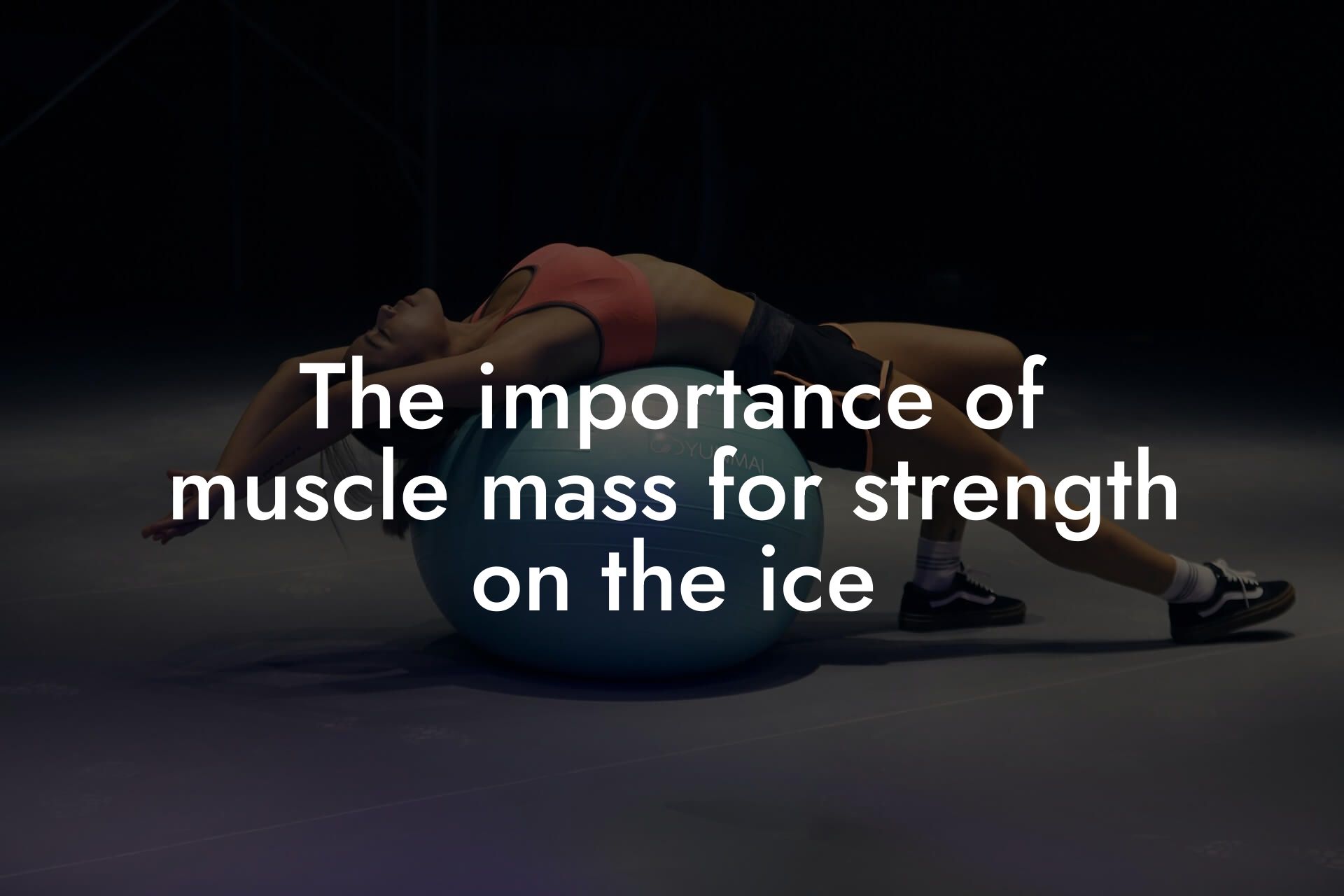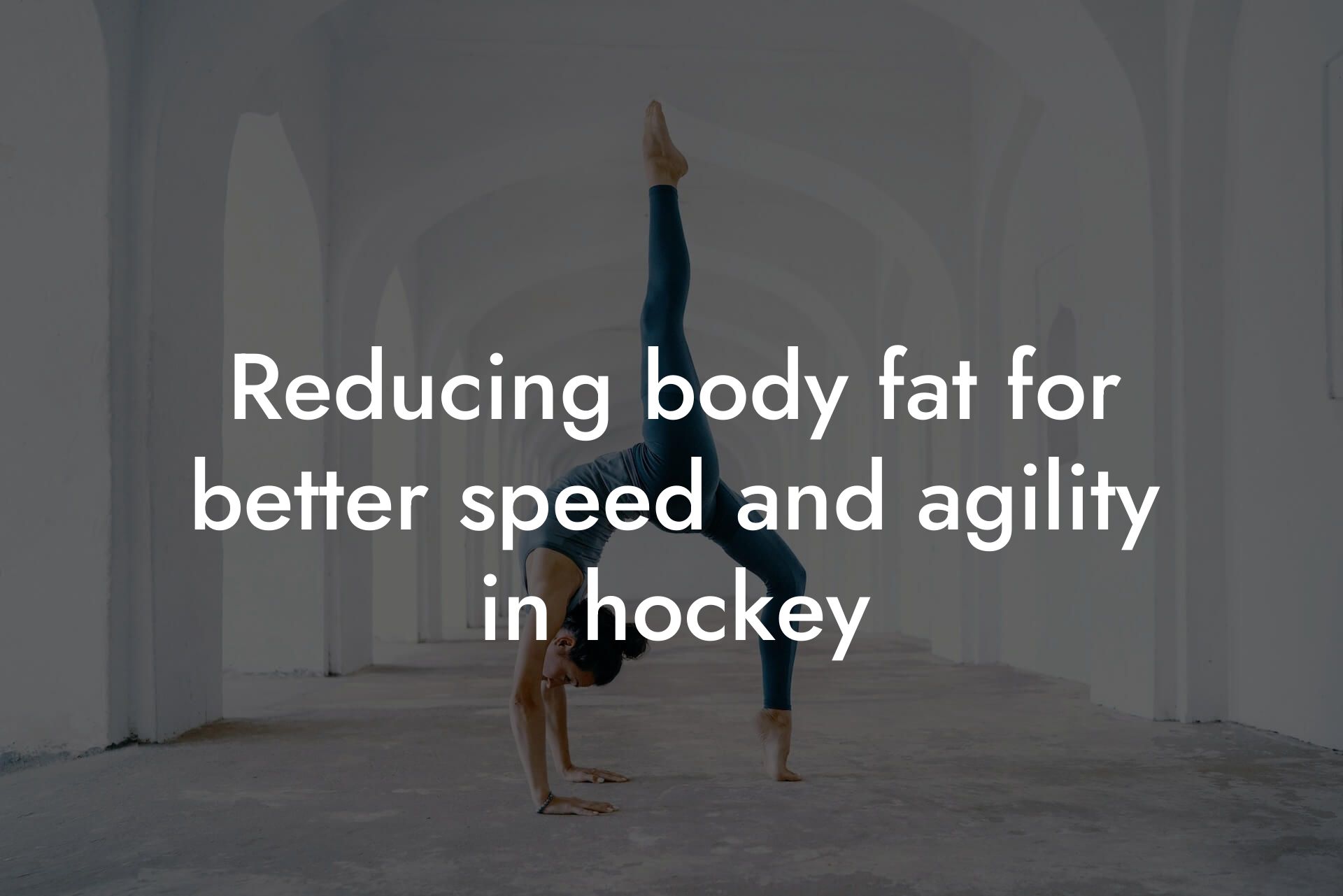Introduction
As a high-earning professional, you understand the importance of maintaining a strong physical appearance, low body fat, and a toned physique. But when it comes to hockey, it's not just about looking good – it's about performing at your best on the ice. To excel in hockey, you need to strike a delicate balance between strength, speed, and agility. In this article, we'll delve into the importance of each component, how they interact, and provide you with actionable tips to improve your overall hockey performance.
Table of Contents
The Importance of Strength in Hockey
Strength is the foundation of hockey performance. It's the ability to generate power, speed, and endurance on the ice. A strong hockey player can accelerate quickly, maintain speed, and withstand physical contact. Without sufficient strength, you'll struggle to keep up with the pace of the game, and your overall performance will suffer.
There are several types of strength that are essential for hockey players, including:
- Maximal strength: The ability to generate maximum force in a single effort.
- Power strength: The ability to generate force quickly.
- Endurance strength: The ability to sustain effort over a prolonged period.
A well-structured strength training program should focus on exercises that improve these types of strength, such as squats, deadlifts, and bench press.
The Role of Speed in Hockey
Speed is the ability to move quickly and efficiently on the ice. It's the difference between getting to the puck first and being left behind. A fast hockey player can create scoring opportunities, evade opponents, and maintain possession of the puck.
There are several components of speed that are critical for hockey players, including:
- Acceleration: The ability to quickly change direction and speed.
- Deceleration: The ability to slow down quickly and maintain control.
- Top-end speed: The ability to maintain high speeds over a prolonged period.
A well-structured speed training program should focus on exercises that improve acceleration, deceleration, and top-end speed, such as sprints, agility drills, and plyometric exercises.
The Importance of Agility in Hockey
Agility is the ability to quickly change direction, speed, and movement pattern on the ice. It's the ability to react to changing situations and make split-second decisions. A agile hockey player can evade opponents, create scoring opportunities, and maintain possession of the puck.
There are several components of agility that are critical for hockey players, including:
- Change of direction: The ability to quickly change direction and speed.
- Reaction time: The ability to react quickly to changing situations.
- Movement pattern recognition: The ability to recognize and adapt to different movement patterns.
A well-structured agility training program should focus on exercises that improve change of direction, reaction time, and movement pattern recognition, such as cone drills, ladder drills, and shuttle runs.
How to Balance Strength, Speed, and Agility
Balancing strength, speed, and agility requires a well-structured training program that incorporates exercises that improve each component. Here are some tips to help you achieve balance:
- Periodize your training: Divide your training into specific periods that focus on strength, speed, and agility.
- Incorporate multi-planar movements: Incorporate exercises that move your body in multiple planes of motion, such as squats, lunges, and step-ups.
- Use plyometric exercises: Incorporate plyometric exercises, such as box jumps and depth jumps, to improve power and speed.
- Incorporate agility drills: Incorporate agility drills, such as cone drills and ladder drills, to improve change of direction and reaction time.
Sample Training Program
Here's a sample training program that incorporates exercises to improve strength, speed, and agility:
- Monday (Strength Day): Squats, deadlifts, bench press, and rows.
- Tuesday (Speed Day): Sprints, agility drills, and plyometric exercises.
- Wednesday (Rest Day)
- Thursday (Agility Day): Cone drills, ladder drills, and shuttle runs.
- Friday (Strength Day): Lunges, step-ups, and leg press.
- Saturday (Speed Day): Sprints, agility drills, and plyometric exercises.
- Sunday (Rest Day)
Balancing strength, speed, and agility is critical for hockey performance. By incorporating exercises that improve each component, you can take your game to the next level. Remember to periodize your training, incorporate multi-planar movements, and use plyometric exercises to improve power and speed. With a well-structured training program and dedication, you can achieve optimal hockey performance.
How DEXA Can Help
At Tano Performance Group, we understand the importance of balancing strength, speed, and agility in hockey. That's why we offer DEXA body composition analysis to help you optimize your training program. With DEXA, you can:
- Track changes in body fat percentage and lean mass.
- Identify areas of muscle imbalance.
- Optimize your nutrition and training program.
By incorporating DEXA into your training program, you can take your hockey performance to the next level and achieve optimal results.
Frequently Asked Questions
What is the importance of balancing strength, speed, and agility in hockey?
As a hockey player, balancing strength, speed, and agility is crucial for optimal performance on the ice. Strength provides the power to shoot, pass, and hit, while speed allows for quick movements and agility enables rapid changes of direction. A well-balanced combination of these three components enables players to outmaneuver opponents, maintain possession of the puck, and ultimately score goals.
How do I know if I need to focus on improving my strength, speed, or agility?
Assess your game by identifying areas where you struggle. Do you get pushed around in the corners? Focus on building strength. Do you struggle to keep up with faster opponents? Work on increasing your speed. Do you have trouble quickly changing direction? Agility training may be the key. A balanced training program will help you identify and address weaknesses in all three areas.
What are some exercises to improve strength in hockey?
Focus on exercises that work multiple muscle groups at once, such as squats, deadlifts, and bench press. These exercises will help improve your overall strength, power, and explosiveness. Additionally, incorporate plyometric exercises like box jumps and depth jumps to improve your ability to generate force quickly.
How can I improve my speed on the ice?
Speed training for hockey involves a combination of on-ice and off-ice exercises. On-ice drills like sprints, shuttles, and crossovers can help improve your acceleration and deceleration. Off-ice, focus on exercises like resisted sprints, hill sprints, and agility ladder drills to improve your overall speed and quickness.
What are some agility drills I can do to improve my hockey performance?
Agility drills like cone drills, ladder drills, and shuttle runs can help improve your ability to quickly change direction and accelerate. Incorporate drills that mimic game situations, such as weaving through cones or around small obstacles, to simulate the demands of hockey.
How often should I train for strength, speed, and agility?
A well-structured training program should include a balance of strength, speed, and agility training. Aim to train for strength 2-3 times per week, speed 1-2 times per week, and agility 1-2 times per week. Be sure to include rest and recovery days to allow your body to adapt and rebuild.
Can I improve my strength, speed, and agility simultaneously?
Yes, it is possible to improve all three components simultaneously. A well-designed training program can incorporate exercises and drills that work on multiple components at once. For example, a plyometric exercise like a box jump can improve both strength and speed.
How does nutrition play a role in balancing strength, speed, and agility?
Nutrition plays a critical role in supporting your training. Focus on consuming a balanced diet that includes lean protein, complex carbohydrates, and healthy fats. Adequate hydration is also essential for optimal performance. A well-nourished body will be better equipped to adapt to the demands of training and competition.
What are some common mistakes hockey players make when training for strength, speed, and agility?
Common mistakes include overemphasizing one component over the others, neglecting proper warm-up and cool-down routines, and failing to incorporate rest and recovery days. Additionally, neglecting to focus on functional exercises that mimic game movements can lead to poor transfer of training to game performance.
How can I incorporate plyometric exercises into my training program?
Plyometric exercises, such as box jumps and depth jumps, can be incorporated into your strength training program 1-2 times per week. Start with lower intensities and progress to more challenging exercises as you build power and explosiveness.
What is the role of flexibility and mobility in hockey performance?
Flexibility and mobility are essential for optimal hockey performance. Proper range of motion and flexibility can help reduce the risk of injury and improve overall movement efficiency. Incorporate stretching and mobility exercises into your training program to maintain optimal flexibility and mobility.
How can I improve my acceleration and deceleration on the ice?
Acceleration and deceleration can be improved through a combination of on-ice and off-ice training. On-ice drills like sprints and crossovers can help improve your ability to quickly accelerate and decelerate. Off-ice, focus on exercises like resisted sprints and agility ladder drills to improve your overall speed and quickness.
What is the importance of proper equipment fitting in hockey?
Proper equipment fitting is essential for optimal performance and injury prevention. Ensure that your skates, helmet, and pads fit properly to allow for efficient movement and reduce the risk of injury.
How can I improve my reaction time and response to changing game situations?
Reaction time and response to changing game situations can be improved through a combination of on-ice and off-ice training. On-ice drills like game-like scenarios and small-area games can help improve your reaction time and decision-making. Off-ice, focus on exercises like agility ladder drills and reaction training to improve your overall reaction time and quickness.
What are some common injuries in hockey and how can I prevent them?
Common injuries in hockey include concussions, groin pulls, and knee injuries. These injuries can be prevented through a combination of proper training, equipment fitting, and on-ice awareness. Incorporate exercises that strengthen your core, hips, and legs to reduce the risk of injury.
How can I incorporate strength training into my off-season program?
The off-season is an ideal time to focus on building strength. Incorporate a strength training program that targets all major muscle groups, including your legs, core, and upper body. Aim to train 2-3 times per week and include exercises like squats, deadlifts, and bench press.
What is the role of mental preparation in hockey performance?
Mental preparation is essential for optimal hockey performance. Focus on developing a strong mindset through visualization, positive self-talk, and breathing exercises. A strong mental game can help you stay focused and composed under pressure.
How can I improve my endurance and stamina on the ice?
Endurance and stamina can be improved through a combination of on-ice and off-ice training. On-ice drills like interval training and conditioning exercises can help improve your endurance. Off-ice, focus on exercises like cardio and high-intensity interval training to improve your overall endurance and stamina.
What are some common myths about training for hockey?
Common myths include the idea that strength training will make you slow, that speed training is only for forwards, and that agility training is only for defensemen. These myths are untrue, and a well-balanced training program should include a combination of strength, speed, and agility training.
How can I incorporate conditioning exercises into my training program?
Conditioning exercises, such as pro agility shuttles and beep tests, can be incorporated into your training program 1-2 times per week. These exercises will help improve your endurance and stamina on the ice.
What is the importance of recovery and rest in hockey training?
Recovery and rest are essential for optimal hockey performance. Adequate rest and recovery allow your body to adapt to the demands of training and competition, reducing the risk of injury and improving overall performance.
How can I stay motivated and engaged in my training program?
Staying motivated and engaged can be achieved through goal-setting, tracking progress, and finding a training partner or coach. Celebrate small victories and stay focused on your long-term goals to maintain motivation and engagement.
Here are some related articles you might love...
- Nutrition tips for maintaining energy on the ice
- The importance of muscle mass for strength on the ice
- Reducing body fat for better speed and agility in hockey
- Off-season training strategies for amateur hockey players
- Recovery techniques for hockey athletes after games
- How body composition affects hockey performance
- Strength and conditioning programs for hockey players
- The benefits of DEXA scans for amateur hockey players
- Bone density and injury prevention in hockey
Zak Faulkner
Zak Faulkner is a leading authority in the realm of physical health and body composition analysis, with over 15 years of experience helping professionals optimise their fitness and well-being. As one the experts behind Tano Performance Group, Zak has dedicated his career to providing in-depth, science-backed insights that empower clients to elevate their physical performance and overall health.
With extensive knowledge of DEXA technology, Zak specializes in delivering comprehensive body assessments that offer precise data on body fat, muscle mass, bone density, and overall physique. His expertise enables individuals to make informed decisions and achieve their fitness goals with accuracy and confidence. Zak’s approach is rooted in a deep understanding of human physiology, combined with a passion for helping clients unlock their full potential through personalised strategies.
Over the years, Zak has earned a reputation for his commitment to excellence, precision, and client-focused service. His guidance is trusted by top professionals who demand the best when it comes to their health. Whether advising on fitness programs, nutritional strategies, or long-term wellness plans, Zak Faulkner’s insights are a valuable resource for anyone serious about taking their health and fitness to the next level.
At Tano Performance Group, Zak continues to lead our Content Team revolutionising how professionals approach their physical health, offering unparalleled expertise that drives real results.




